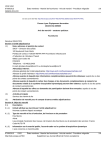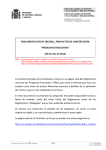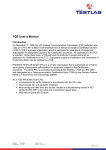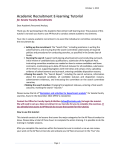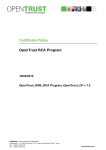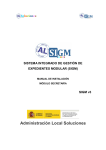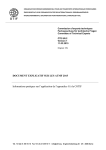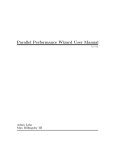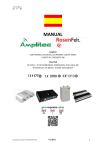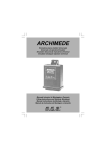Download Preguntas Frecuentes
Transcript
SECRETARIA GENERAL DE INDUSTRIA Y DE LA PEQUEÑA Y MEDIANA EMPRESA MINISTERIO DE INDUSTRIA, ENERGÍA Y TURISMO DIRECCIÓN GENERAL DE INDUSTRIA Y DE LA PEQUEÑA Y MEDIANA EMPRESA Subdirección General de Calidad y Seguridad Industrial REGLAMENTO (UE) Nº 305/2011, PRODUCTOS DE CONSTRUCCIÓN “PREGUNTAS FRECUENTES” (30 de Mayo de 2013) La Comisión Europea ha comenzado a incluir en su página web del Reglamento una serie de “Preguntas Frecuentes” (FAQ), que serán el vehículo que ésta va a emplear para tratar de aclarar diferentes aspectos y detalles de la aplicación del mismo. En este documento se presentan las preguntas frecuentes disponibles hasta su fecha de emisión. Se incluye una traducción al español de las preguntas, así como su texto original en inglés y, en caso de dudas, predominará el texto inglés. La página web de la Comisión, en la que se pueden ver estas preguntas es: http://ec.europa.eu/enterprise/sectors/construction/faq/index_en.htm Pº DE LA CASTELLANA, 160 - 28071 MADRID CORREO-E: [email protected] 1/11 TLF. :91 349.44.10 FAX: 91 349.43.00 ________ “PREGUNTAS FRECUENTES” 1. ¿Debe un producto de construcción llevar el marcado CE después del 30/06/2013? Para vender un producto de construcción en la Unión Europea (EU) después del 30/06/2013, el fabricante tiene la obligación de emitir una Declaración de Prestaciones (DdP) y colocar el marcado CE si: El producto está cubierto por una Norma Europea Armonizada y ha finalizado el periodo de coexistencia, O Si se ha emitido una Evaluación Técnica Europea para el producto. NOTA: Si es aplicable alguna de las excepciones establecidas en el Artículo 5 del Reglamento de Productos de Construcción, el fabricante puede abstenerse de emitir una DdP y fijar el marcado CE. Esta es una decisión que deberá tomar el fabricante, que puede emitir una DdP, y colocar el marcado CE, incluso en estos casos. 2. Un fabricante vende un producto con el marcado CE en la UE antes del 01/07/2013. ¿Qué tiene que hacer para vender el producto en la UE después del 1/7/2013? El fabricante puede continuar vendiendo el producto después del 1/7/2013 con la condición de que: Haya emitido una Declaración de Prestaciones (DdP) según el Anexo III del Reglamento de Productos de Construcción (CPR) y proporcione una copia al cliente; los fabricantes pueden redactar una DdP en base al certificado de conformidad o declaración de conformidad, que han sido expedidos antes del 01/07/2013 de acuerdo con la Directiva de Productos de Construcción 89/106/CEE (DPC); Haya fijado el marcado CE, seguido de la información requerida en el Articulo 9(2) del RPC; Se haya abstenido de fijar marcas comerciales, signos o inscripciones que puedan inducir a error a terceros sobre el significado o el formato del marcado CE. 3. Después del 01/07/2013, ¿un distribuidor está obligado a retirar de sus instalaciones los productos de construcción que haya recibido antes del 01/07/2013 y que: a) ya ostentaban el marcado CE según la Directiva de Productos de Construcción 89/106/CEE (CPD) pero no están acompañados por una Declaración de Prestaciones (DdP)?, o 2/11 MINISTERIO DE INDUSTRIA, ENERGÍA Y TURISMO ________ b) no llevan el marcado CE aunque estén cubiertos por una Norma Europea Armonizada bajo la DPC? No, él puede continuar vendiendo estos productos hasta que se agote el stock de producto suministrado antes del 01/07/2013. Para cualquier nuevo suministro de productos de construcción que le sea entregado por el fabricante después del 01/07/2013, el distribuidor debe solicitar al fabricante que le facilite la Declaración de Prestaciones (DdP) de esos productos y que esté fijado el marcado CE sobre ellos. 4. ¿Cuál es el significado de “puesta en el mercado”? Vender el producto (individual) por primera vez en el Mercado Interior Europeo. NOTA: Cada producto o partida de productos (esto es, cada ventana o cada paquete / camión de ladrillos) se pone en el mercado individualmente. El hecho de que anteriormente se hayan comercializado productos similares, no modifica esto. En consecuencia, los fabricantes tienen que redactar una Declaración de Prestaciones (DdP) y fijar el marcado CE de conformidad con el Reglamento de Productos de Construcción (RPC) para todos los productos que se introduzcan en el mercado del 01/07/2013 en adelante, aunque se hayan comercializado productos similares antes de esa fecha. 5. Si el fabricante no ha realizado ninguna modificación en su producto, ¿está obligado a realizar nuevamente los ensayos o informes de evaluación o a solicitar nuevos certificados de los Organismos Notificados para reemplazar a los emitidos antes del 01/07/2013? No, no es necesario volver a hacer las evaluaciones ni renovar los certificados después del 01/07/2013. Si el fabricante no ha realizado ninguna modificación en su producto sería necesario renovar los ensayos/ informes de evaluación existentes únicamente: Si la EN armonizada ha sido modificada para incluir otros métodos de ensayo/evaluación para las características esenciales para las que el fabricante tiene intención de declarar sus prestaciones Y Si estas modificaciones en los métodos de evaluación pudieran dar lugar a cambios significativos en la prestación declarada. Si el organismo de certificación que ha expedido el certificado no ha sido notificado para el Reglamento de Productos de Construcción (RPC), dicho organismo no podrá continuar realizando las tareas de Evaluación y Verificación de la Constancia de las Prestaciones 3/11 MINISTERIO DE INDUSTRIA, ENERGÍA Y TURISMO ________ después del 01/07/2013 y, en consecuencia, el fabricante tendrá que elegir otro organismo de certificación de entre los notificados para el Reglamento de Productos de Construcción. Un fabricante deberá re‐evaluar el producto siempre que introduzca un cambio en el mismo. 6. ¿Puede utilizarse un documento de idoneidad técnica Europeo para comercializar un producto después del 01/07/2013? En caso afirmativo ¿durante cuánto tiempo? El Artículo 66 del Reglamento de Productos de Construcción (RPC) establece que los fabricantes pueden utilizar las documentos de idoneidad técnica Europeos expedidos antes del 01/07/2013 como Evaluaciones técnicas Europeas durante todo el periodo de validez de estos documentos de idoneidad técnica Europeos. En consecuencia el fabricante podrá, sobre la base de un documento de idoneidad técnica Europeo ya existente, redactar la Declaración de Prestaciones (DdP), poner el marcado CE y vender el producto en la UE. Cuando el documento de idoneidad técnica Europeo esté próximo a su caducidad, el fabricante puede solicitar una Evaluación Técnica Europea a uno de los Organismos de Evaluación Técnica competentes, autorizados y notificados para el RPC. La relación actualizada de los Organismos de Evaluación Técnica estará disponible antes del 01/07/2013 y en adelante en: http://ec.europa.eu/enterprise/newapproach/nando/index.cfm?fuseaction=notifiedbody.no tifiedbodies&num=TAB&text=Technical%20Assessment%20Body 7. Para un producto que no está cubierto por una norma armonizada ¿está el fabricante obligado, después del 01/07/2013, a solicitar una Evaluación Técnica Europea para vender el producto en la UE?. En este caso, el fabricante no está obligado a solicitar una Evaluación Técnica Europea. El fabricante puede vender también el producto sin la Declaración de Prestaciones (DdP) ni el marcado CE Además, el fabricante puede esperar que el producto no sea rechazado en otros Estados Miembros de la UE. En este contexto, es importante recordar el Reglamento (EU) 764/2008, por el que se establecen los procedimientos relativos a la aplicación de las normas técnicas nacionales a los productos comercializados legalmente en otro Estado miembro, poniendo en práctica el principio de mutuo reconocimiento. 4/11 MINISTERIO DE INDUSTRIA, ENERGÍA Y TURISMO ________ 8. ¿Qué se entiende por “Documentación Técnica Adecuada” según se establece en el Artículo 36 del Reglamento de Productos de Construcción (RPC)? Es la documentación que el fabricante considera apropiada para justificar los procedimientos que utiliza para declarar el comportamiento del producto en los casos establecidos en el Artículo 36 del RPC. En el caso del Artículo 36(1)a la Documentación Técnica Adecuada puede utilizarse, por ejemplo, para demostrar que se cumplen unas condiciones específicas para la aplicación de una Decisión de la Comisión que defina la clase de reacción al fuego del producto. En el caso del Artículo 36(1)b o 36(1)c la Documentación Técnica Adecuada puede consistir, por ejemplo, en resultados de ensayo obtenidos por otro fabricante, o por el proveedor del sistema, junto con su autorización para la utilización de estos resultados y las justificaciones para la correspondencia de los productos en cuestión (punto b) o del seguimiento de las instrucciones dadas (punto c). Se sobreentiende que la Documentación Técnica Adecuada puede ser diferente de unos productos de construcción a otros, según las particularidades de cada caso. El fabricante deberá conservar esta documentación del producto de construcción en la documentación técnica del producto con el objeto de que le permita justificar adecuadamente la Declaración de Prestaciones (DdP) en el caso de que las autoridades de vigilancia de mercado u otras se la requieran. 9. ¿Qué debe hacer un fabricante si algún capítulo de la norma armonizada no está en línea con las disposiciones del Reglamento de Productos de Construcción (RPC)? El Reglamento de productos de Construcción (RPC) es la legislación aplicable directamente en todos los Estado Miembros de la UE. Por lo tanto, en tales casos, es esta legislación la que prevalece. La consecuencia es que tales cláusulas conflictivas de la norma no pueden aplicarse. Los Comités Técnicos de CEN tienen encomendado el trabajo de eliminar lo antes posible cualquier inconsistencia en las normas armonizadas pero, no se puede excluir que todavía existan algunas inconsistencias después del 01/07/2013, presumiblemente por un corto espacio de tiempo. 10. ¿Dónde se puede obtener información sobre los requisitos aplicables a un producto en un determinado Estado Miembro? Cualquier persona interesada puede obtener dicha información en los Puntos de Contacto nacionales para Productos de Construcción establecidos por cada Estado Miembro. 5/11 MINISTERIO DE INDUSTRIA, ENERGÍA Y TURISMO ________ 11. ¿Son los Organismos Notificados los encargados de comprobar si el fabricante cumple con sus obligaciones bajo el Reglamento de Productos de Construcción (RPC)? Los actos legales de la Directiva de Productos de Construcción (DPC) (Decisiones de la Comisión) y, después, del RPC establecen el tipo y nivel de intervención de una tercera parte. Como resultado, tanto las especificaciones técnicas armonizadas (Normas europeas Armonizadas o Documentos de Evaluación Europeos), contienen los detalles necesarios de las tareas de los Organismos Notificados con objeto de asegurar la Evaluación y verificación de la Constancia de las Prestaciones (denominadas “tareas de EVCP”). Estas son las tareas que se espera que los Organismos Notificados cumplan en el marco del RPC. Se espera que los Organismos Notificados se abstengan de realizar actividades en el ámbito de la vigilancia de mercado (puesto que éstas van a ser realizadas por las autoridades nacionales de vigilancia del mercado), o de verificar el cumplimiento de las obligaciones del fabricante que se establecen en el RPC. Por ejemplo, no es competencia de los Organismos Notificados comprobar si el fabricante ha redactado correctamente la Declaración de Prestaciones (DdP), o si ha fijado correctamente el marcado CE. 12. Los Artículos 7(3) y 60 del Reglamento de Productos de Construcción (RPC) prevén un acto delegado para definir las condiciones para que una declaración de prestaciones pueda ser procesada electrónicamente, con el fin de incluirla en la página web. ¿Cuándo se espera que esté aprobado este acto delegado? ¿Pueden los fabricantes mientras tanto continuar facilitando la Declaración de Prestaciones (DdP) en una página web? Se espera que el Acto Delegado de la Comisión sea adoptado en septiembre de 2013. Después se enviará al parlamento Europeo y al Consejo para su aprobación. Al final del procedimiento, el Acto delegado (probablemente un reglamento) será publicado en el Diario Oficial de la UE. Mientras tanto, los fabricantes pueden continuar la práctica de proporcionar la información sobre las prestaciones de sus productos en una página web. 13. ¿Cuál es el significado de la frase “los dos últimos dígitos del año en el que se colocó por primera vez el marcado”, del Articulo 9(2) del Reglamento de Productos de Construcción (RPC)? Estos dígitos se refieren al año en el que se puso en el mercado por primera vez este tipo de productos y, por lo tanto, se mantendrá sin cambios a lo largo de años siempre que las prestaciones del producto no sufran ninguna variación. En la práctica, esto significa que si el fabricante ha comercializado productos similares con marcado CE correspondientes a un cierto conjunto de prestaciones (un producto‐tipo determinado) a partir de 2009, estos dos 6/11 MINISTERIO DE INDUSTRIA, ENERGÍA Y TURISMO ________ dígitos siguen siendo 09 incluso después del 01/07/2013, cuando el marcado CE presentará algunos cambios debidos al RPC. 14. ¿Cuál es la importancia del manual de instalación / instrucciones? Cabe esperar que la prestación declarada de un producto se mantenga a condición de que el producto sea correctamente instalado. Esto es particularmente relevante para productos que se venden en forma de kit para su instalación final en la obra de construcción. Por lo tanto, es fundamental, para garantizar la correcta instalación del producto, el papel de las instrucciones de montaje o las instrucciones de instalación, que deberá proporcionar el fabricante de conformidad con el Artículo 11(6) del Reglamento de Productos de la Construcción (RPC). 7/11 MINISTERIO DE INDUSTRIA, ENERGÍA Y TURISMO ________ FREQUENTLY ASKED QUESTIONS 1. Must a construction product bear the CE marking after 30/06/2013? After 30/06/2013, in order to sell a construction product in the European Union (EU) the manufacturer has the obligation to issue a Declaration of Performance (DoP) and affix the CE marking if: the product is covered by a harmonised European Standard and the coexistence period has ended, OR if a European Technical Assessment has been issued for the product. NB: If one of the derogations foreseen in Article 5 of the Construction Products Regulation is applicable, the manufacturer is entitled to refrain from drawing a DoP and affixing the CE marking. This is a decision to be taken by the manufacturer, who can issue a DoP and affix the CE-marking even in these cases. 2. A manufacturer sells in the EU before 01/07/2013 a product with the CE marking. What does he have to do in order to sell the product in the EU after 1/7/2013? The manufacturer can after 1/7/2013 continue selling the product under the condition that: he has drawn up a Declaration of Performance (DoP) in line with Annex III to the Construction Products Regulation (CPR) and provides a copy to the client; manufacturers may draw up a DoP on the basis of a certificate of conformity or a declaration of conformity, which has been issued before 01/07/2013 in accordance with the Construction Products Directive 89/106/EEC (CPD); he has affixed the CE marking, followed by the information required in Article 9(2) of the CPR; he refrains from affixing to the product markings, signs or inscriptions which are likely to mislead third parties regarding the meaning or form of the CE marking. 3. After 01/07/2013, is a distributor obliged to withdraw from his shop construction products which the distributor has received before 01/07/2013 and: a/ which were already CE marked in line with the Construction Products Directive 89/106/EEC (CPD) (CPD) but are not accompanied by a Declaration of Performance (DoP)?, or b/ which do not bear the CE marking although they are covered by a harmonised European standard under the CPD? No, he can continue selling these products till the stock he has been delivered before 01/07/2013 is exhausted. For any new delivery of construction products which will be dispatched to him by the manufacturer from 01/07/2013 onwards, the distributor must request the manufacturer to supply the Declaration of Performance (DoP) for these products and to affix the CE marking on them. 4. What is the meaning of "placing on the market"? Selling the (individual) product for the first time within the European Internal Market. 8/11 MINISTERIO DE INDUSTRIA, ENERGÍA Y TURISMO ________ NB: Every product or batch of products (that is, every window or every package / truckload of bricks) is placed on the market individually. The fact that similar products have been marketed before, does not change this. Therefore, manufacturers have to draw up a Declaration of Performance (DoP) and affix the CE marking pursuant to the Construction Products Regulation (CPR) for all the products entering the market from 01/07/2013 onwards, even if similar products had been commercialised before this date. 5. If the manufacturer has not changed anything in his product, is he obliged to renew after 01/07/2013 the existing test or assessment reports, or request from Notified Bodies new certificates to replace the ones issued before 01/07/2013? No, the assessments do not need to be redone or the certificates renewed after 01/07/2013. If the manufacturer has not changed anything in his product the existing test/assessment reports and certificates would need to be renewed only: if the harmonised EN has changed to include other test/assessment methods for the essential characteristics for which the manufacturer intends to declare the performance, AND if these changes in the assessment methods would have as effect significant changes in the declared performance. If the certification body which has issued the certificate has not been designated under the Construction Products Regulation (CPR), this body cannot continue carrying out the Assessment and Verification of Constancy of Performance tasks after 01/07/2013 and therefore the manufacturer will have to choose another certification body which has been designated under the Construction Products Regulation. A manufacturer must have the product re-assessed if he has changed the product. 6. Can a European technical approval be used to market a product after 01/07/2013? If yes, for how long? Article 66 of the Construction Products Regulation (CPR) foresees that manufacturers may use European technical approvals issued before 01/07/2013 as European Technical Assessments throughout the period of validity of these European technical approvals. Therefore the manufacturer can, on the basis of the existing European technical approval, draw up theDeclaration of Performance (DoP), affix the CE marking and sell the product in the EU. When the European technical approval is about to expire, the manufacturer may request a European Technical Assessment from one of the competent Technical Assessment Bodies designated under the CPR. An updated list of Technical Assessment Bodies shall be available at the latest from 01/07/2013 onwards in: http://ec.europa.eu/enterprise/newapproach/nando/index.cfm?fuseaction=notifiedbody.not ifiedbodies&num=TAB&text=Technical%20Assessment%20Body 9/11 MINISTERIO DE INDUSTRIA, ENERGÍA Y TURISMO ________ 7. For a product which is not covered by a harmonised standard, is the manufacturer after 01/07/2013 obliged to request a European Technical Assessment in order to sell the product in the EU? The manufacturer is not obliged to request a European Technical Assessment in this case. He can also sell the product without Declaration of Performance (DoP) and CE marking. Furthermore, the manufacturer can expect that the product will not be refused in other EU Member States. In this context it is important to remember Regulation (EU) 764/2008 laying down procedures relating to the application of national technical rules to products lawfully marketed in another Member State, thus operationalizing the mutual recognition principle. 8. What is the "Appropriate Technical Documentation" foreseen in Article 36 of the Construction Products Regulation (CPR)? It is the documentation which the manufacturer considers appropriate in order to justify the manner he uses to declare the performance of the product in the cases foreseen in Article 36 of the CPR. In the case of Article 36(1)a the Appropriate Technical Documentation may e.g. be used to demonstrate that the specific conditions are met for the application of a Commission Decision defining the reaction to fire class of the product. In the cases of Article 36(1)b or 36(1)c the Appropriate Technical Documentation may e.g. consist of the test results obtained by another manufacturer, or the system provider, together with his authorisation to use these results, and the justifications for the correspondence of the products in question (point b) or for due respect of the instructions given (point c). It is understood that the Appropriate Technical Documentation could well be different from one situation or construction product to the other, according to the particularities of each case. It will be kept by the manufacturer of the construction product in the technical file of the product in order to allow him to properly justify the Declaration of Performance (DoP) in case market surveillance or other authorities require so. 9. What shall a manufacturer do if certain clauses in the harmonised standard are not in line with the provisions of the Construction Products Regulation (CPR)? The Construction Products Regulation (CPR) is the directly applicable legislation in every EU Member State. Therefore in such cases, of course, it is this legislation which prevails. The consequence is that such conflicting clauses of standards cannot be applied. The CEN Technical Committees have undertaken the work to iron out the soonest possible any such inconsistencies in the harmonised standards but it can not be excluded that some inconsistencies may remain after 01/07/2013, presumably for a short time only. 10. Where can somebody obtain information on the requirements applicable to a product in a specific Member State? Any interested person can obtain such information from the national Product Contact Point for Construction established by each Member State. 10/11 MINISTERIO DE INDUSTRIA, ENERGÍA Y TURISMO ________ 11. Are Notified Bodies expected to check whether the manufacturer meets his obligations under the Construction Products Regulation (CPR)? The legal acts based on the Construction Products Directive (CPD) (Commission Decisions) and, later on the CPR foresee the kind and level of intervention of the 3rd party. As a result, both harmonised technical specifications (harmonised European standards, or the European Assessment Documents), contain the necessary detailed tasks for the Notified Bodies in order to ensure the Assessment and Verification of Constancy of Performance (the so called “AVCP tasks”). These are the tasks which the Notified Bodies are expected to fulfil in the framework of the CPR. Notified Bodies are expected to completely refrain from activities belonging to the area of market surveillance (as these are to be undertaken by the national market surveillance authorities), or from verifying the compliance of the manufacturer with his obligations under the CPR. As an example, it is not for Notified Bodies to check if the manufacturer has correctly drawn up the Declaration of Performance (DoP), or if the manufacturer has correctly affixed the CE marking. 12. Articles 7(3) and 60 of the Construction Products Regulation (CPR) foresee a delegated act to define the conditions on which a declaration of performance may be electronically processed, in order to make it available on a web site. When is this delegated act expected to be issued? Can in the meanwhile manufacturers continue uploading the Declaration of Performance (DoP) on a website? The Commission's Delegated Act is expected to be adopted by September 2013. It will then be transmitted to the European Parliament and the Council for their reaction. At the end of the procedure the Delegated Act (most probably a Regulation) will be published in the Official Journal of the EU. In the meanwhile, manufacturers can continue their practice to provide information about the performance of their products on a website. 13. Which is the meaning of the phrase “the last two digits of the year in which the marking was first affixed”, in Article 9(2) of the Construction Products Regulation (CPR)? These digits refer to the year that these kinds of products were made available on the market for the first time and therefore they will remain unchanged over the years as long as the performance of the product has not changed. In practice, this means that if the manufacturer has marketed similar CE marked products corresponding to a certain set of performance (a given product-type) from 2009 onwards, these two digits continue to be 09 even after 01/07/2013, when the CE marking will undergo some changes due to the CPR. 14. What is the importance of the installation manual / instructions? The declared performance of the product is expected to be achieved under the condition that the product is correctly installed. This is particularly relevant for products which are sold as a kit in order to be installed in the final construction work. Therefore, the role of the installation manual or installation instructions, which are to be provided pursuant to Article 11(6) of the Construction Products Regulation (CPR) by the manufacturer, is very important to ensure the correct installation of the product. 11/11 MINISTERIO DE INDUSTRIA, ENERGÍA Y TURISMO












